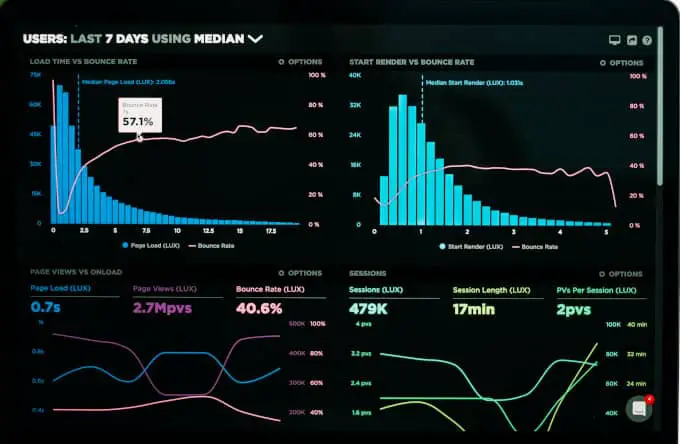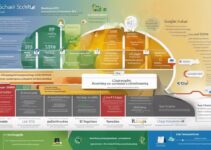What is big data analytics? How can the process support decision-making in businesses? How does it work, and what does it take to become a data analyst? This article explains the answers to three typical business questions.
The Meaning of Big Data Analytics
Big data and statistical software applications are powerful tools that large businesses use to further their agenda. The information age presents opportunities to dabble with voluminous data generated from the internet or other electronic data capture systems to output information that decision-makers can use. Analyzing these large volumes of data refers to big data analytics.
Benefits of Big Data Analytics
How will data gathered from the internet or electronic data capture systems be of benefit to decision-makers? Of what use are those data?
From a statistician’s or data analyst’s point of view, the large amounts of data available for analysis mean a lot. It can show patterns and trends to predict future outcomes.
Moreover, data analysis can become more meaningful when guided by specific questions at the beginning of data analysis. Data remains as data unless data collection pursues a stated research goal, purpose, or set of objectives.
However, when large amounts of data are collected using a wide range of variables or parameters, it is still possible to analyze those data to see relationships, trends, differences, among others. Extensive databases serve this purpose. They are ‘mined’ to produce information.
Hence, the term “data mining” arose from this practice.
Big Data Analytics Application in Business Decision-Making
In this discussion, I emphasize data generation and information as output for effective executive decision-making. Analyzed data gives valuable insights for smart business decision-making.
Data is meaningless unless purposeful data analysis is applied. Asking the right research questions guides the logical approach in data analysis.
Thus, executives are well armed with insights to prevent decision-making blunders. And they do it faster and better than when they do not have these tools at hand.
Loss of profit, mismanagement of personnel, or producing a poor product that does not meet customer needs and demands will be averted.
What It Takes to Become a Data Analyst
Data analysts are a crucial part of the business decision-making process. Their role is to interpret the results of the data analysis for decision-makers.
If you intend to become a data analyst, the following video enumerates five key points to expect when working in this field. Excellent science background and adeptness in using statistical software applications will prove invaluable.
Three Example Uses of Big Data Analytics
An executive of a large, multinational company may, for example, ask three questions:
- What is the sales trend of the company’s products?
- Do sales approach a predetermined target?
- What is the company’s share of the total product sales in the market?
What kind of information do executives need, and why do they ask such questions?
Executives expect aggregated information or a bird’s-eye view of the situation. Big data analytics can quickly provide the answers to these questions.
Hence, a large company, or even a medium-sized company with the technological capability and human resources to leverage on the findings of big data analytics, makes a business competitive.
1. Determining Sales Trend
A simple line graph to show product sales since its launching summarizes market data and shows sales trends.
Just by simple inspection of graphs, an executive, with the help of the data analyst, can easily see the ups and downs of product sales. It presents an opportunity to identify the factors affecting those fluctuations. Thus, actions become timely and relevant.
Further, if three products are presented in a graph simultaneously, it would be easy to spot which one performs better. If the sales trend dipped somewhere, the executive can ask what caused such a dip in sales.

Hence, decisive action corrects a problematic situation. A sudden surge in sales shows an effective information campaign.
2. Assessing The Outcome of Sales Approach
How about that question on meeting a predetermined target? A simple comparison of unit sales using a bar graph showing targeted and actual accomplishments achieves this end.
3. Determining the Share of Total Product Sales
The third question may be addressed by showing a pie-chart to show the percentage of product sales relative to those of the other companies. Thus, information on the company’s competitiveness is produced.
These graph outputs, if based on large amounts of data, are more reliable than just simply getting randomly sampled data because there is an inherent error associated with sampling. Samples may not correctly reflect a population. Greater confidence in decision-making, therefore, is given to such an analysis backed by large volumes of data.
Data Sources for Big Data Analytics
How are large amounts of data amassed for analytics in online-oriented businesses?
Whenever you subscribe, log in, join, or make use of any internet service like a social network or an email service for free, you become a part of the statistics. Simply opening your email and clicking products displayed on a web page will provide information on your preference.
The data analyst can relate your preference to the profile you gave when you subscribed to a service. But your preference is only a point in the correlation analysis. More data is required for analysis to take place.
Hence, aggregating all the behavior of internet users will provide better generalizations.
Sourcing the data required by businesses requires time, money, and effort. Thus, some companies leverage published data online or purchase data from data providers who have those data.
As the target customer of big businesses, chances are, whatever information you provide whenever you subscribe, login, or make use of an online product, tool, or facility, you unwittingly provide the data that businesses need.
The sale of data generated through this means is a lucrative business. Putting them to good use helps businesses thrive while using that information to the detriment of the customers or users leads to greater privacy concerns.
Hence, laws and regulations in different places in the world regarding data privacy rose into prominence in recent years.
Summary
This discussion highlights the importance of big data analytics. When it becomes a part of an organization’s decision support system, better decision-making by executives is achieved.
Data analysts synthesize data using exploratory data analysis to enable faster and better decision-making that makes businesses become competitive in their respective industries.
Reference
TimeAtlas.com (August 23, 2011). Web server logs and internet privacy. Retrieved August 28, 2013, from http://www.timeatlas.com/web_sites/general/web_server_logs_and_internet_privacy#.Uh1Dbb8W3Zh
© 2021 December 1 P. A. Regoniel
[cite]



